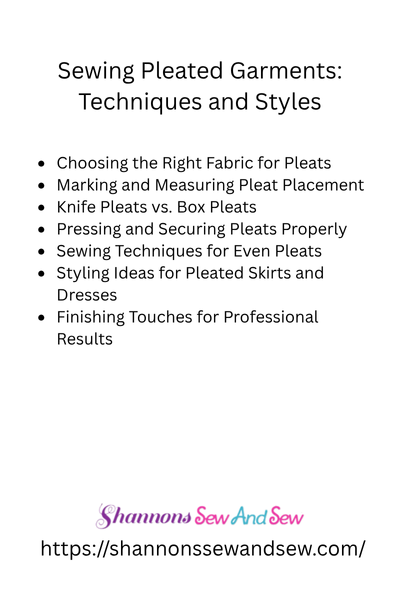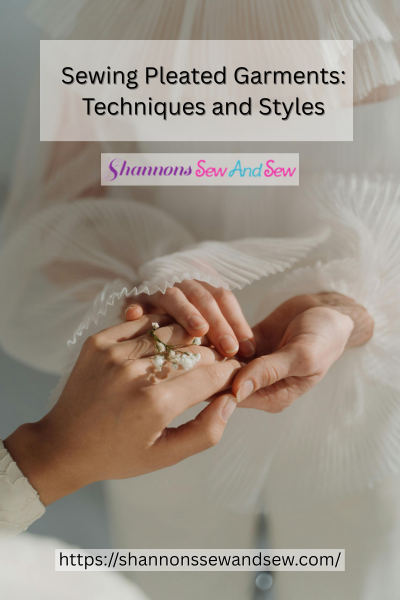Sewing Clothes
Sewing Pleated Garments: Techniques and Styles
Sewing pleated garments can seem like a daunting task at first, but trust me, once you get the hang of it, you’ll be hooked! Whether you’re looking to make a pleated skirt for a special occasion or add some flair to a shirt, the process can be surprisingly easy and fun. I’m here to share all the sewing pleated garments techniques and styles you need to master.
I remember the first time I tried pleating fabric. I was so nervous, and honestly, it felt like I was trying to fold a hundred pieces of paper into perfect little triangles. But the moment I saw that fabric transform into something beautiful, I was hooked. If you’re just starting out or want to improve your pleating game, stick with me—I’ll walk you through it.
Read More About Sewing Pleated Garments: Techniques and Styles

Why Pleats Are Worth the Effort
Pleats aren’t just for fancy dresses or skirts. They add texture and style to a variety of garments—think pleated shirts, trousers, even jackets! The beauty of pleating is that it creates movement and structure at the same time, making your garments look more polished and put-together. Plus, it’s a great way to elevate a simple piece of fabric into something special.
When I first tried sewing pleated garments, I had no idea how to get those perfectly crisp folds. I thought I needed some kind of magic, but after experimenting with different techniques, I realized it’s all about precision and patience. It doesn’t take as much time as you might think to master, and the results are totally worth it.
More Things to Know About Sewing Pleated Garments: Techniques and Styles

Different Pleating Techniques You Should Know
So, you’re ready to dive in and start pleating? Awesome! There are a few different methods you can try, each with its own charm.
Knife Pleats: Clean and Crisp
Knife pleats are what most people picture when they think about pleated skirts or dresses. These pleats all face in the same direction, creating a clean, uniform look. They’re perfect for achieving that sleek, tailored appearance.
To make knife pleats, you’ll need to carefully measure and press your folds. I recommend using a fabric marking tool to keep everything lined up. Once the pleats are pressed, sew them in place using a long, straight stitch. Don’t forget to press the pleats again after sewing—it’ll really help them stay sharp.
Box Pleats: Balanced and Structured
Box pleats are a bit more versatile than knife pleats, and I find them super fun to sew. They alternate directions, creating a symmetrical pattern that looks great on skirts, dresses, or even the pleated panels of a shirt. I use box pleats a lot because they give garments a structured but still comfortable look.
To make box pleats, you’ll fold the fabric in one direction, then fold it back in the opposite direction. Again, using a fabric marking tool will make it easier to keep everything aligned. When it comes to sewing, make sure your pleats are evenly spaced—this can take a little trial and error, but it’s worth the effort.
Accordion Pleats: Tiny and Tight
If you want to add some serious texture to your garment, accordion pleats are the way to go. These pleats are much smaller and tighter than knife or box pleats, which gives them a more intricate, detailed look. They’re often seen in skirts and dresses for a soft, feminine touch.
To sew accordion pleats, you’ll need to work with a finer fabric, as this will allow the pleats to fold more easily. The key is to press each pleat really well to get that sharp, accordion-like effect. I’ve found that using a pleating board can make this process a lot faster and more accurate.
Fabrics That Work Well for Pleating
When choosing fabric for pleats, you’ll want something that holds the folds well. Lighter fabrics like chiffon or cotton are a great choice because they hold pleats beautifully without getting too bulky. Heavier fabrics like wool or denim can also be pleated, but the folds might not be as crisp.
I’ve learned through trial and error that fabrics with a bit of structure are ideal. For example, linen or even a heavier cotton blend will hold pleats more easily than something too silky or flimsy. So, before you get started, consider the fabric’s weight and drape—it makes a big difference in how the pleats turn out.
Common Mistakes When Sewing Pleated Garments
Even experienced sewers make mistakes when it comes to pleating. Here are a few things to watch out for:
- Uneven pleats: This can be frustrating, but it’s usually because the pleats weren’t measured properly before you started. Make sure you take your time with the marking and pinning to keep them uniform.
- Fading or distorted pleats: Pressing your pleats too aggressively can sometimes flatten them out, so always use a light touch with your iron.
- Skipping the basting stitch: It’s tempting to skip this step, but trust me—it’ll save you a lot of headaches in the long run. Basting the pleats in place before sewing them down can help you keep everything neat and aligned.
The Pleated Garment Styles You Should Try
Okay, now that you’ve got the techniques down, let’s talk about some pleated garment styles you can make! Pleats aren’t just for skirts and dresses. With a little creativity, you can incorporate pleats into all sorts of looks.
Pleated Skirts
A classic pleated skirt is always a winner. You can go for a knee-length pleated mini or an elegant floor-length pleated style. No matter the length, pleats add so much texture and flow.
Pleated Trousers
If you’re feeling adventurous, why not try pleated trousers? These can look incredibly sharp with the right fabric, and they work well for both casual and formal occasions. Pair them with a simple button-down shirt for a stylish, tailored look.
Pleated Shirts
I’ve also seen some cool pleated shirt designs lately—think pleated panels on the front or pleats at the cuffs. Adding pleats to a shirt can turn a basic garment into something really unique.
Creating Movement and Style with Every Fold
Sewing pleated garments might seem intimidating at first, but with a bit of practice and patience, you’ll be able to create stunning pieces that show off your sewing skills. Whether you’re working with knife pleats, box pleats, or accordion pleats, there’s so much you can do with this technique.
I can’t wait to see what pleated garments you create next—trust me, it’s totally worth the effort! Happy sewing.




















